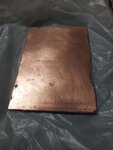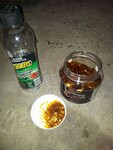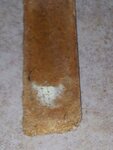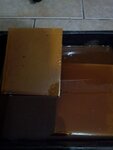boylesg
Advanced Member level 4

- Joined
- Jul 15, 2012
- Messages
- 1,023
- Helped
- 5
- Reputation
- 10
- Reaction score
- 6
- Trophy points
- 1,318
- Location
- Epping, Victoria, Australia
- Activity points
- 11,697
I had some success with copper plating this weekend.
I got an used matrix board and painted the reverse side with a graphite paint I made. I mixed White nite kill rust clear with some lubricating graphite to a creamy texture and then painted the fibreglass surface. I gave it a very rough sand and then electroplated in copper suulfate solution with a little sulfuric acid using a car battery re-charger overnight.
It starts off plating very slowly but speeds up as the copper area grows.
I didn't bother completing it was just to see if it would stick and it has. The copper surface pretty rough but if you built up enough of a layer you could sand it back and make it smooth.
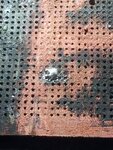
As you can see I soldered on to it and it did not delaminate. The rough copper surface made it a little hard to get the solder to take but that would be solved by sanding the copper back.
Then I tried coating 3mm MDF in the same white night epoxy paint but even 3-4 coats is not water proof. The MDF is to dense, absorbs the epoxy paint like a giant sponge and it would require MANY coats - too much hassle. Perhaps the fact that I did not leave it to dry overnight first compounded the problem
Next I will instead try embedding 1.5mm thick balsa wood in white nite fibre glass resin and see if I can electroplate that. Fibre glass resin should render the balsa wood water proof. The fibreglass resin should do a better job at waterproofing and the basla wood is no where near as dense as MDF.
Those matrix board are a pain because the copper ringlets delaminate easily of you put the soldering iron on them for too long or on more than once occasion. And the copper clad boards for etching are rather expensive and would probably suffer the same problem as the matrix board.
It is no good for you profssionals but perfectly doable for amateurs like me.
I got an used matrix board and painted the reverse side with a graphite paint I made. I mixed White nite kill rust clear with some lubricating graphite to a creamy texture and then painted the fibreglass surface. I gave it a very rough sand and then electroplated in copper suulfate solution with a little sulfuric acid using a car battery re-charger overnight.
It starts off plating very slowly but speeds up as the copper area grows.
I didn't bother completing it was just to see if it would stick and it has. The copper surface pretty rough but if you built up enough of a layer you could sand it back and make it smooth.

As you can see I soldered on to it and it did not delaminate. The rough copper surface made it a little hard to get the solder to take but that would be solved by sanding the copper back.
Then I tried coating 3mm MDF in the same white night epoxy paint but even 3-4 coats is not water proof. The MDF is to dense, absorbs the epoxy paint like a giant sponge and it would require MANY coats - too much hassle. Perhaps the fact that I did not leave it to dry overnight first compounded the problem
Next I will instead try embedding 1.5mm thick balsa wood in white nite fibre glass resin and see if I can electroplate that. Fibre glass resin should render the balsa wood water proof. The fibreglass resin should do a better job at waterproofing and the basla wood is no where near as dense as MDF.
Those matrix board are a pain because the copper ringlets delaminate easily of you put the soldering iron on them for too long or on more than once occasion. And the copper clad boards for etching are rather expensive and would probably suffer the same problem as the matrix board.
It is no good for you profssionals but perfectly doable for amateurs like me.
Last edited:

